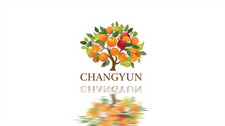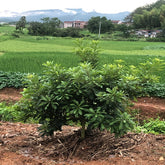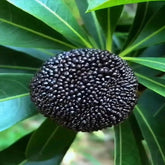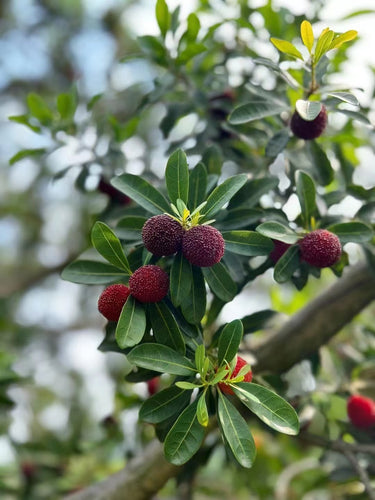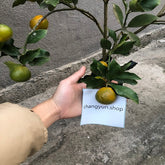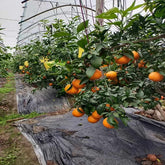Dongkui Myrica rubra/Yangmei cultivation method
30 Nov 2023
Preparation for planting&Garden site selection
Dongkui Myrica rubra likes light and moisture, tolerates shade and cold, has low soil requirements, and has strong adaptability. It can be planted in mountains and hills. Plantation first
Choose red soil, yellow soil and sandy loam soil with loose soil, high organic matter content, good drainage and a pH value of 4.5~5.5; use sufficient sunlight and precipitation.
Gentle slopes with plenty of water, an altitude of less than 800 m, and a slope of less than 45˚ are preferred. In order to facilitate later management and transportation, etc., you should also choose a location with convenient transportation.
Profitable place. The Myrica rubra fruit has no peel and the exposed pulp is eaten directly. Therefore, the site of the garden should be far away from industrial areas to reduce pollution and be close to the road.
There must be a certain distance to prevent dust contamination.
Variety selection
There are many types of Myrica rubra. Although they are highly adaptable, in order to obtain the greatest economic benefits, the planting site and soil should be comprehensively considered when selecting varieties.
Soil conditions, climate characteristics and other factors, and market-oriented, select popular and excellent varieties suitable for local planting. Selected in variety
It is also necessary to scientifically combine early, mid- and late-maturing varieties such as Zaojia, Water Chestnut Zhong, Ding'ao Mei, and Dongkui to extend the picking period of Myrica rubra fresh fruits and the market.
supply period and improve economic benefits. The main varieties cultivated in Wencheng County are highly adaptable, strong tree vigor, strong resistance, high yield, large fruit size, and economical.
Dongkui Yangmei has remarkable economic benefits.
Early-bearing and high-yielding cultivation and management techniques
Seedling planting and seedling selection
Selecting seedlings with good quality can improve the survival rate of transplanted seedlings. When selecting seedlings, you must choose seedlings with good growth status, strong trees, and pure varieties.
Positive, seedlings with more fibrous roots, no pests and diseases, and no mechanical damage. Generally, it is required to plant seedlings that are two to three years old with soil, with a height of more than 1.0 m, and a crown
Stems over 1.2 m.
Colonization method
When planting, remove the grafting wrapping film, cut off all the leaves, and shorten the trunk. Put straw, straw, plant ash, etc. into the planting hole.
For green manure, put the seedlings with mud balls into the planting holes, mix them evenly with organic fertilizer and surface soil, and then cover them with soil. After the colonization is completed,
To water tightly to avoid root leakage, it is best to spread a layer of grass on the soil surface of the orchard to protect moisture. The Yangmei type is relatively shallow, so be careful when planting it.
The depth should not be too deep to avoid affecting the survival of the seedlings. The spacing between rows of Myrica rubra trees on hillside is generally 5 m × 5.5 m. Scientific and reasonable spacing between rows is beneficial to
Later management, picking and other work are carried out.
Plastic trimming
In order to achieve high yield and high quality of Myrica rubra, it is essential to carry out scientific shaping and pruning work. Myrica rubra trees usually use multi-main branch dwarfs and open circles.
The head shape and crown are generally controlled below 4 m, and the width is about 4 m. Pruning is mainly done in winter. In other seasons, it depends on the development of the tree.
Rows are trimmed appropriately. Generally, thinning and short pruning are the main methods, and diseased and weak branches, leggy branches, dead branches, late autumn shoots, cross branches, etc. are cut off. To Myrica rubra
When cutting branches, be sure to apply a protective agent on the wound, and the large branches must be wrapped with thatch or painted with whitening agent for protection.
Flower and fruit management, flower and fruit combing
Too much Dongkui Myrica rubra fruit will lead to nutrient loss, resulting in smaller fruits, poor taste, poor quality, delayed maturity, and weakened fruit.
Tree vigor hinders the differentiation of flower buds and affects the amount of fruit next year. Therefore, scientific flower and fruit thinning work is to avoid the occurrence of big and small years and to ensure that
A necessary link for high yield and high quality of Myrica rubra. Thinning flowers and fruits mainly follows the principle of "thinning less strong trees and more thinning weak trees".
Flower thinning of Dongkui Myrica rubra is usually carried out before budding in spring to remove branches that are too weak or too dense. For Myrica rubra trees with too many flower buds, you can combine them with winter
Seasonal pruning removes excess fruiting branches.
Dongkui Myrica rubra fruits and vegetables are usually carried out about 20 days after the Myrica rubra flowers fade, and manual fruit thinning work is carried out 2 to 3 times, with an interval of 7 to 10
d. Generally follow the principle of retaining the strong and removing the weak, and remove diseased and insect-infected fruits, weak and small fruits, and deformed fruits. Generally speaking, Myrica rubra fruit thinning generally removes the amount of fruit
40%~70%, only 1~2 fruits are left on each fruiting branch, and no more than 3 fruits are left on each fruiting branch, while one or two fruits are left on each fruiting branch of the Dongkui variety.
Reality. Timely and scientific manual thinning of branches and fruits can improve the quality of Dongkui Myrica rubra single fruits, increase the commercial rate, and improve the quality. The effect is obvious.
write.
Soil, fertilizer and water management, soil management
Deep plowing of the soil should be carried out every autumn, with a depth of 10 to 15 cm. Deep plowing should be carried out in conjunction with soil fertility and fertilization.
This can improve soil fertility, increase soil permeability, avoid soil compaction, allow the roots to respire better, and promote new growth.
Generation of roots.
moisture management
Myrica rubra needs a lot of water during the budding and fruit expansion stages, and timely watering is required at this time. In the rainy seasons of spring and summer, it is necessary to make timely arrangements
Work with water to prevent the roots from being soaked in water and causing diseases, which will affect the healthy growth of the tree.
Fertilizer management
Scientific and reasonable fertilization is an important link to ensure early fruiting, high yield and high quality of Dongkui Myrica rubra. Young trees should be fertilized with more nitrogen and water fertilizers, which will help
Easy to absorb, can form a healthy tree body. Fertilization of adult Dongkui Myrica rubra mainly follows the principle of "potassium fertilizer should be applied heavily, nitrogen fertilizer should be controlled, and phosphorus fertilizer should be reduced."
According to the principle, when fertilizing, attention should be paid to scientific proportions. Adult trees are generally fertilized twice a year, and the frequency of fertilization may be increased appropriately depending on the development of the tree.
The first time is before budding in spring, and the second time is after fruit picking. Fertilization mainly includes groove-shaped, radial, and extra-root fertilization. Dongkui Yangmei
Foliar fertilizer should also be applied during the hard-core stage of the fruit, which will help the fruit color, increase yield, increase fruit shape, and improve marketability.
Green prevention and control
In order to reduce the pests and diseases of Dongkui Myrica rubra trees as much as possible and ensure early and high-quality Myrica rubra production, corresponding pest and disease prevention work must be carried out.
Take precautions before they happen. It is necessary to reduce the use of pesticides with high residues, high toxicity and high pollution, and adopt more methods such as agricultural control, physical control and biological control.
The main diseases of Myrica rubra include onion disease, white rot, wilt disease, cancer disease, sclerotinia disease, etc.; the main pests include Drosophila melanogaster, whitefly, and black-winged soil.
Termites, leaf rollers, aphids, etc. In response to the above diseases, it is necessary to promptly and scientifically prune diseased and insect-infested plants, dead branches, weak branches, etc., and to focus on scientific treatment.
Such as centralized burning; daily management work should also be strengthened, scientific fertilization and rational use of pesticides should be carried out according to the growth of the tree, so as to improve soil fertility and increase
Strengthen tree vigor, thereby improving the disease and insect resistance of the tree itself. To target the above pests, methods such as yellow boards, light lures, and hormone lures can be used.
Traps pests and protects natural enemies such as ladybugs and parasitic wasps from pests.
Fruit harvesting
The maturity period of Dongkui Myrica rubra fruits is not synchronized. The fruits are exposed without peel and are easy to be damaged. Therefore, they must be picked in batches, and they must be picked and handled gently during harvesting.
Picking can be started when about 1/5 of the fruits of the whole tree are mature. Generally, picking is done in the morning or evening to avoid picking on rainy days.
After picking, it must be transported to a cool place in time for heat dissipation and pre-cooling, and storage and transportation must be carried out in a timely manner to improve the economy and quality of the fruit.
In conclusion
In summary, in order to improve the quality and yield of Dongkui Myrica rubra fruits, excellent seedlings should be selected for planting. After loading the seedlings for planting,
To carry out scientific management, it is necessary to carry out scientific pruning, flower and fruit management in a timely manner, adopt sophisticated soil, fertilizer and water management methods and green prevention and control, etc.
Only in this way can we ensure that Dongkui Myrica rubra will bear fruit early and have a high yield. 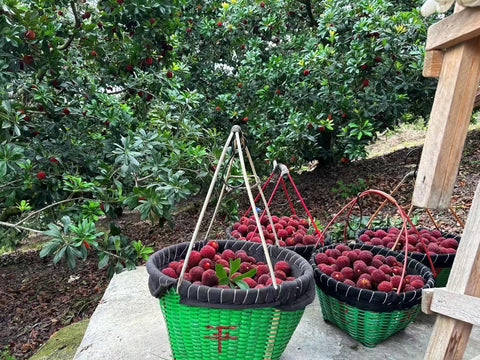
Tags:
